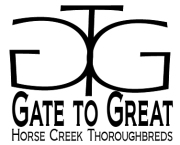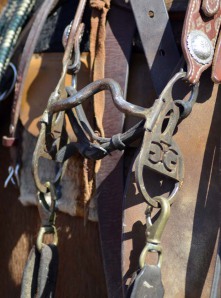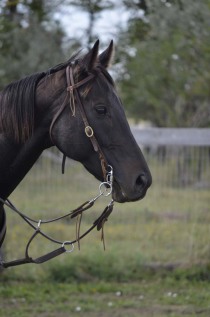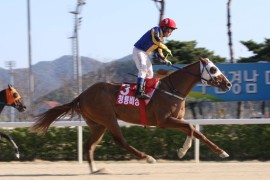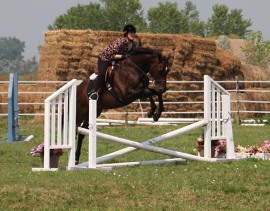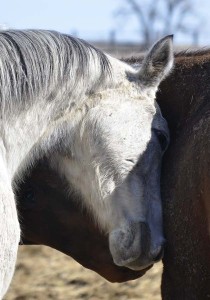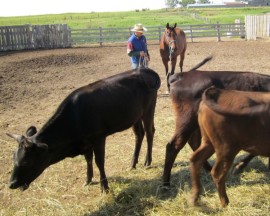
The Untracked Mind Blog
A Bit On Bits
When asked about favorite bits, a friend of mine said, "I use the kind of bit that comes on a headstall." Well, I can get along with about any bit if I have to, but I have a few favorites for retraining off-track Thoroughbreds to be ranch mounts and work cattle. As a former jockey and later, a trainer who galloped my own string, I have an advantage getting into the mindset of the racehorse to "untrack" him.
The first thing I change in a retired racehorse's routine is the feel of all the tack he wears, from the heft of a western saddle with double cinches, to his headgear and bit. At the track, a ring snaffle and direct rein contact is the norm, so I take my training the opposite direction by riding with a curb bit, which uses leverage, and I stay off the horse's mouth. With long days gathering cattle on varying terrain, a horse has to learn to balance himself, so I can't be worrying about riding on contact or "wearing out the brakes."
My curb bits usually have a solid, thick mouthpiece with a mild port in the center for tongue relief and moderate shank length of around two inches, with big rings to keep the horse from lipping or grabbing the shanks. I like a "sweet iron" mouth, which is steel and gets better as it develops a coating of rust through use. A "correction bit" with shanks which move independently of each other is another handy transition too. The weight of a heavier bit is useful for keeping the head carriage lower, as are the harness leather training forks (running martingale) I make and use daily. I prefer a leather curb strap, as it tends to have less "bite" on the chin groove than a chain curb.
While some of my bits have a fixed shank and others a swivel action, I ride a curb bit with two hands until the horse has advanced to roping. This gives me a chance to introduce the leverage effect of the curb while incorporating some direct rein cues already familiar to the racehorse. Adding leg, spur and outside rein helps progress the horse toward neck reining, or indirect reining.
I seldom use broken-mouth curbs, sometimes mistakenly called a leverage snaffle, because of the nut-cracker effect on the jaws. While tack catalogs are full of this type of bit, I find it easier to fix tongue issues and quiet the jaw with a solid bit. Sometimes, taking a bit to the shop to weld, file and modify it to suit my needs is the only way to end up with the piece of equipment I want to use for a given horse.
Some bit companies like to rank the severity of a bit on the level of the horse, but I think it should be based on the level of the rider. Bits, reins or long-reins are no better than the hands at the other end.
He'll Be Worth It
This is the face of a horse our fans have never met.
The face of a horse that since the day we got him a year ago this week, we were never sure he'd pull through and make it and we didn't want our fans to go through the pain of losing him like we quite often felt we might.
A horse that came to us with casts on all four hooves, ankles the size of softballs and was hurting.
A horse that even without his physical issues wasn't exactly a "looker"--shorter, a bit long in the back and a rather oddly put together overall, he was never going to be the horse anyone picked out of the crowd at a racetrack backside and took home.
Welcome to a Champion!
If the text on the saddlecloth in the photo above looks a little unfamiliar, don't worry. It was a surprise to us too!
Meet Cheongnyong Bisang, the 2013 Champion Two-Year-Old....of South Korea.
So how did the Two-Year-Old Champion of South Korea end up starting a new life as a ranch horse in South Dakota? It's a bit of a long story, but through our great network of trainers, owners and friends, we heard about this horse after plans to race him in the U.S. and then stand him at stud went sour with the rest of the breeding industry during the recession. After being castrated, we gave him a new nick-name that was easier to pronounce, "Doc Ruel", (in honor of the veterinarian who saved him for us) and a new career as a ranch horse.
As we had hoped, he took to the cattle work like an old pro and spent many long days out on the wide-open ranges of South Dakota and Wyoming. After seeing his delight in popping over jumps, a friend in Florida thought he'd work well in the hunt field doing duty as a whipper-in. "Doc Ruel" is currently spending the winter down south adding to his resume, but is available for purchase. This could be your next gem in the hunt field or upper level event horse, not to mention big mover in the dressage arena. Call or email us for details.
Thoroughbreds for the Rest of Us: Why TBs?
Thoroughbreds for the Rest of Us is a new blog series by Dale's partner in Gate to Great and in life, Dorothy Snowden. It will chronicle how Thoroughbreds are a part of the lives of "regular folks" rather than professional trainers, racing owners and breeder. People like Dorothy, who are adult amatuer riders who just want a horse to enjoy a smaller slice of the equestrian life, in the showring and out of it.
How Do You Do? Herd Socialization
Here at the ranch, our herd is constantly expanding, contracting and changing as horses come, go and move around within different groups. We constantly monitor the social health of each group and look for ways that we create groups that provide a stress free life for each horse in it.
There are many variables when introducing new horses into a group and when you are introducing an off-track Thoroughbred, which may not have been turned out in a group setting in several years, there are extra precauctions to be taken.
Overcoming Fear of Cattle-The Remember Shiney Story
We get a lot of questions from people all over about how to overcome fear of cattle in their horses. The short answer is time and patience. We thought we would share this little story of the Thoroughbred gelding, Remember Shiney, whose fear of cattle was so strong he could not even be pastured in a field next to them. In the course of a week, through patient and careful handling, Dale was able to turn this formerly fearful gelding into a confident cow horse! Read more here...
2013 Year In Review Video
This year saw a lot of changes for our operation here at Gate to Great/Horse Creek Thoroughbreds. Thank you to everyone who made it possible!
A Little Winter Video
It's cold and we are bored, so we thought we would make these fun little videos of the boys. Enjoy!
A Thank You to Duck
As many of you know, our RRTP Thoroughbred Makeover Duck has become very special to us and his journey over the summer of 2013 certainly changed our own. This video is a tribute to what he means to us.
2013 Newell Ranch Rodeo Preview Show
Ok, so we have SO MUCH amazing footage from Saturday's Newell Ranch Rodeo that getting it organized is proving a monstrous task. So we took a few of the best clips and made a quick "preview"
of all the fun we had. "Team Duck" rocked!
Not only did Team Duck WIN the rodeo, but we also took the "Shoot-Out" at the end, which pits the top 4 teams against each other in one final competition. We also won two "Top Hand" awards when
Team Duck member Allen Stirling took the overall "Top Hand" and our youth roper, Jace Engesser, took "Top Youth Hand" on his little buckskin, Bucky, who was also named "Top Horse". Our other
team members included Karen Seaman (on the pretty Palomino) and our mutton buster, Ben Ismay...both of whom did a fine job!
And let's hear it for the horses...Duck at his very first rodeo did GREAT and Swingn Slew filled in at the end to make sure the always-chaotic sheep tee pee went to plan when we saw we were in the
running to win.
All in all, it was a pretty good sweep for Team Duck!
Look for some more footage later this week, but for now we leave you with "The Preview Show". Enjoy!
Neck Reining for OTTBs
ANSWER:
Teaching neck reining is a natural progression that can be broken down into simple elements, as any other skill a horse learns. A Thoroughbred coming out of race training is accustomed to direct rein cues from a snaffle bit, but is typically weak on responding to leg cues, as the shortened leg position of an exercise rider or jockey inhibits the use of leg as an aid. The horse has to learn to work off leg pressure, combined with direct rein, before he can move on to understanding rein pressure across his neck. READ MORE...
A Little Spring Branding
We assisted some neighbors branding calves this past weekend. Of the 230+ calves, Dale's horse, Swingn Slew roped and brought to the branding crew a fourth or more...this after spending 4+ hours
rounding them up! Retired at age 5 in 2011 after 22 starts, this grandson of AP Indy has turned into an absolutely rock solid
ranch horse and a GREAT GELDING! Thoroughbreds have the intelligence to learn any job and the heart to work all day!
Here a video of Slew roping a calf and bringing him into the branding pen:
What's In A Name?
Some days our OTTB's really live up to their name!
Yesterday we assisted our neighbors in moving a group of cows and calves down the road to a new pasture. Dale was mounted on a horse in training, barn name Columbus but his registered name
is "Bold Roar" (Roar x Nellie's Crown by Crowning for you pedigree buffs). Columbus has been in the program since last fall and knows his way around cows, but he learned a whole new lesson on
this trip.
The most difficult part about the route we had these cattle on was the bridge that crosses the creek...it is an old wood plank structure and sits about 30-40 feet above the creek bed
below. But the worst part about this bridge is that it has no guard rails of any kind, just a roa-width of planks and a long drop to the creek below. Needless to say, the cows were not
terribly keen on making the crossing, which made for quite a lot of work for the riders. READ MORE...
